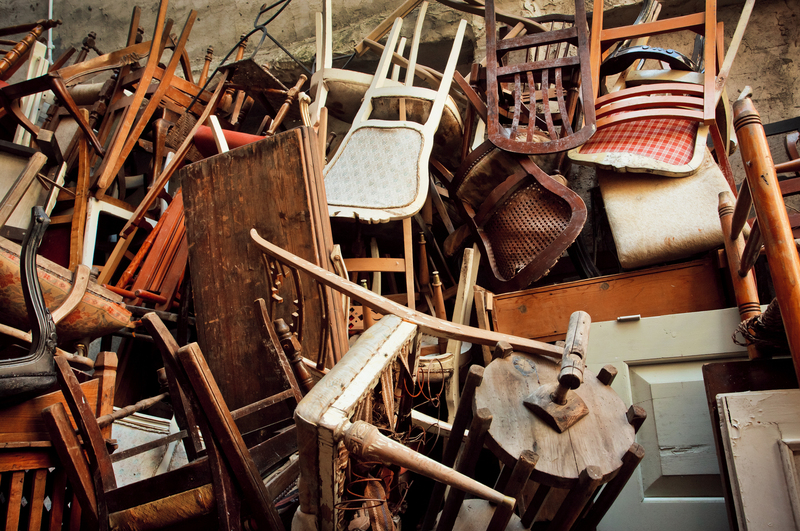Insider Advice for Storing Your Sofa Without Damaging It
Your sofa is often the centerpiece of your living room--a place where you relax, entertain guests, and create memories. Whether you're moving, renovating, or simply need extra space, storing your couch properly is essential to ensure it remains in top condition. In this article, you'll discover insider advice for storing your sofa without damaging it, including expert tips, comprehensive preparation guides, and best practices for keeping your favorite seat as good as new.

Why Proper Sofa Storage Matters
Many people underestimate the importance of careful preparations when it comes to storing a sofa. After all, your couch is an investment, and improper handling can lead to permanent stains, warped frames, unpleasant odors, or pest infestations. By following expert guidance for safe storage, you can extend the lifespan of your furniture and ensure it stays pristine until you're ready to use it again.
Common Risks of Improper Couch Storage
- Moisture buildup causing mold and mildew
- Fabric discoloration due to sunlight exposure
- Wooden frame warping or cracking
- Foam and cushion deformation
- Infestation by pests such as rodents or insects
- Foul odors from poor ventilation
- Accidental tears or scratches during movement
How to Prepare Your Sofa for Storage
The foundation of damage-free sofa storage lies in thorough preparation. Here's a step-by-step guide for getting your sofa ready for its temporary home:
1. Clean Your Sofa Thoroughly
Begin with a deep clean. Lingering dirt, food particles, or stains can worsen over time.
- For fabric sofas: Vacuum all surfaces, including under cushions, to remove dust and debris. Spot-clean stains using a mild upholstery cleaner and allow the fabric to dry completely before storing.
- Leather sofas: Wipe down with a damp cloth and a leather-friendly cleaner. Condition the leather to maintain its suppleness and prevent cracking.
- Wood or metal parts: Dust thoroughly and wipe with a suitable cleanser.
*Avoid storing a damp sofa, as this promotes mold and mildew growth.*
2. Disassemble When Possible
Detaching removable parts can minimize the risk of damage. Consider removing:
- Sofa legs and feet
- Cushions and pillows
- Armrests, if detachable
*Label and bag small parts and screws to make reassembly easier. Keep components together in a sturdy bag or container.
3. Wrap and Protect for Storage
Proper wrapping shields your couch from dust, scratches, and moisture. Here's how to do it right:
- Use clean, breathable covers (like cotton sheets or furniture blankets) instead of plastic tarps, which can trap condensation and cause mildew.
- For extra protection, wrap cushions and pillows individually.
- Secure covers with furniture stretch wrap or packing tape, but never tape directly to the upholstery!
- Place a sheet or cardboard underneath the sofa if storing on a warehouse floor.
4. Choose the Right Storage Environment
The success of safe sofa storage depends on selecting an appropriate space. Your options include:
- Self-storage units: Opt for a climate-controlled facility to protect against temperature fluctuations and humidity, which can warp frames and breed mold.
- Garage or basement: Only consider these if the area is dry and well-ventilated. Use dehumidifiers or moisture absorbers as needed.
- Warehouse space: Ensure it's clean, pest-free, and climate-stable.
*Never store your sofa outside or in a damp area, as this almost guarantees damage.*
Optimal Techniques for Storing Your Sofa Safely
After preparation, the way you position and care for your sofa in storage can make all the difference. The following expert sofa storage tips will help you avoid the most common forms of damage:
1. Store Your Couch Off the Ground
Even in clean units, it's wise to place your sofa on wooden pallets or boards. This simple step:
- Allows air circulation around the sofa
- Prevents moisture absorption from the floor
- Keeps it away from rodents and crawling insects
2. Avoid Stacking Heavy Items on Top
Never place boxes or furniture on top of your stored sofa. The weight can distort the frame, permanently flatten cushions, or tear the upholstery.
3. Position the Sofa for Best Protection
- Place the couch upright, on its feet, as it would stand in your living room.
- Avoid laying it on its side or back for prolonged periods--this risks frame and cushion deformation.
- Allow at least a few inches of space between the sofa and storage unit walls to promote air flow and prevent condensation.
4. Consider Pest Prevention Measures
To safeguard against uninvited guests:
- Use rodent deterrents, such as cotton balls soaked with peppermint oil, around the storage area.
- Double-check your storage facility's pest control policy.
- Inspect the sofa and storage unit regularly for signs of pests.
Additional Insider Tips for Couch Storage Success
Insider advice for storing your couch without damage goes beyond the basics. Here are some advanced tips from storage professionals and furniture care experts:
1. Use Furniture Pads or Blankets Liberally
Soft padding absorbs shocks and prevents accidental scratches during the moving and storage process. Dedicate extra layers to vulnerable corners and arms.
2. Refresh with Baking Soda or Charcoal
To prevent odors, sprinkle baking soda on fabric upholstery and vacuum it off after an hour--or place activated charcoal pouches inside cushion covers. These natural deodorizers keep your sofa smelling fresh while stored.
3. Opt for Vertical Storage If Needed
If you must save space, store the sofa vertically only as a last resort--and for the shortest time possible. Wrap extra padding around corners and ensure the surface it stands on is cushioned and stable.
4. Label Wrapped Pieces Clearly
If you're disassembling your sofa, mark each part and include assembly instructions if possible. This will minimize confusion and reduce risks of parts getting misplaced.
5. Check Your Storage Insurance
Verify whether your homeowner's or renter's insurance covers stored furniture, or ask your storage provider about protection plans. This gives added peace of mind against accidental damage like water leaks, fire, or theft.
What NOT to Do: Biggest Couch Storage Mistakes
To maximize your sofa's longevity, avoid these costly errors:
- Never store a dirty or wet sofa--it will likely develop mold, mildew, or unpleasant smells.
- Don't wrap the couch in non-breathable plastic, which traps moisture and leads to irreparable damage.
- Avoid stacking furniture or heavy objects on top of your couch, as this crushes cushions and damages frames.
- Don't use harsh chemicals or bleach on upholstery; they can deteriorate fabric and fade colors over time.
- Never store your sofa outdoors without full shelter--weather and pests can destroy it within days.
- Don't overlook routine checks. Visit your storage unit periodically to inspect for pests, leaks, or other issues.
Signs Your Sofa Is Suffering in Storage
Even with careful planning, it pays to watch for early warning signs that your storage situation needs improvement. Keep an eye out for:
- Damp smells or visible mold, which indicate high humidity
- Warped or bowed furniture frames
- Flattened, misshapen, or stiff cushions
- Fabric color changes or mysterious stains
- Nibbled edges--possible evidence of rodents
If you notice any of these issues, take immediate action to correct the environment or reposition your sofa as needed.
Bringing Your Sofa Out of Storage: Steps to Restore and Refresh
When you're ready to welcome your couch back into your home, these steps ensure a smooth transition from storage to living room:
- Unwrap and inspect your sofa for damage, pests, or odors before bringing it inside.
- Clean again as needed--unpack cushions, vacuum thoroughly, and wipe down all surfaces.
- Air out the sofa for several hours to release any musty smells or moisture. Setting it out in indirect sunlight is ideal--but avoid too much direct UV.
- Reassemble all detachable parts, using your bagged screws and labeled components.
- For extra freshness, sprinkle lightly with baking soda before use.
With the right approach, your stored sofa can look, feel, and smell just as good as the day it went into storage.

FAQs: Storing Your Sofa Without Damage
How long can I safely store my sofa?
You can store a sofa safely for months or even years with correct preparation and appropriate conditions. For long-term storage, always opt for climate-controlled units and periodic check-ins.
Is a climate-controlled storage unit worth the extra cost?
Yes--especially for leather or antique sofas, as climate control prevents temperature swings and humidity problems that ruin furniture.
Can I store other items inside or on top of my sofa?
No. Additional weight can damage frame integrity and compress cushions. Store items separately for best results.
What's the safest way to move my sofa to and from storage?
Use furniture dollies, carry with at least two people, pad all surfaces, and secure the sofa in transport. Disassemble larger sofas to avoid narrow hallway or doorway accidents.
What is the best material to wrap a sofa in for storage?
Furniture blankets, cotton sheets, or breathable covers are best. Never use airtight plastic tarps directly on upholstery.
Conclusion: Store Your Sofa With Confidence
Investing a little extra effort into storing your sofa without damaging it will pay off for years to come. From thorough cleaning and smart disassembly to using climate-controlled facilities and periodic inspections, every step protects your valuable piece of furniture. Follow these professional tips, and your sofa will be ready to welcome friends, family, and you--whenever you bring it home again!
Remember: The right storage decisions today mean a comfortable, beautiful couch tomorrow. Happy storing!



